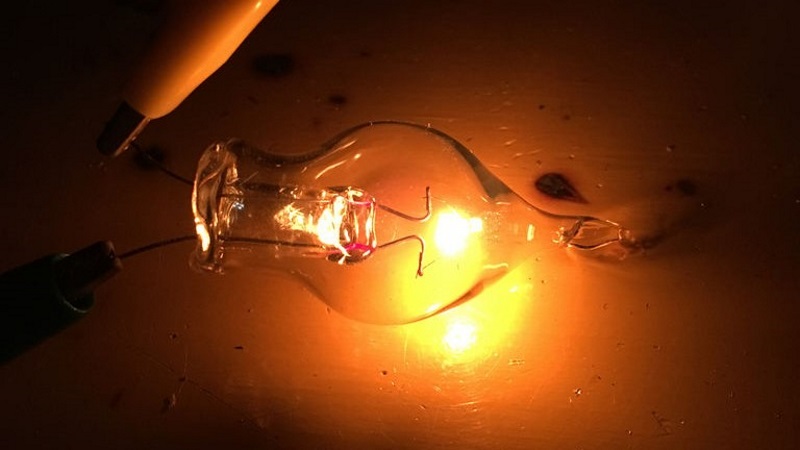With most of the apparatus and instruments we now take for granted yet to be developed, the early pioneers of the Electric Age had to bring a lot to the lab besides electrical skills. Machining, chemistry, and metallurgy were all basic skills that the inventor either had to have or hire in. Most of these skills still have currency of course, but one that was once crucial – glassblowing – has sadly fallen into relative obscurity.
There are still practitioners of course, like [2SC1815] who is learning how to make homemade incandescent light bulbs. The Instructable is in both English and Japanese, and the process is explained in some detail. Basic supplies include soda-lime glass tubing and pre-coiled tungsten filaments. Support wires are made from Dumet, an alloy of iron, nickel, and cobalt with an oxidized copper cladding which forms a vacuum-tight seal with molten glass. The filament is crimped to the Dumet leads and pinched into a stem of glass tubing. A bulb is blown in another piece of tubing and the two are welded together, evacuated with a vacuum pump, and sealed. The bulbs are baked after sealing to drive off any remaining water vapor. The resulting bulbs have a cheery glow and a rustic look that we really like.
Of course, it’s not a huge leap from DIY light bulbs to making your own vacuum tubes. That’s how [Dalibor Farny] got started on his handmade Nixie business, after all.
















One small correction… the bulbs are heated *during* vacuum and *before* sealing to drive out the water. Otherwise the water has nowhere to go.
“heating after sealing” could/should be for tempering the glass – remove residual stress from partial heating
I would expect it to be for annealing, not tempering.
Otherwise you’d have a “wet bulb”
*sneaks away*
Now I’m looking at these dusty CRT monitors(that I’ve put off taking to the recycling center, far too long now) and wondering if I should de-vacum them and snap the necks off. This would be to salvage the electron guns for some sort of never to be done project.
sigh….
https://hackaday.com/2018/09/25/productivity-unfinished-projects-and-letting-go/
When I had to de-vacuum some old TV CRTs in a repair shop I was told to hit the neck with the handle of a suitable (big) screwdriver. I can not remember how much usable length of the neck assembly remained after that – this was 30yrs ago.
Where I used to work we would put a screwdriver in the hole where the anode suction cup (also called ultor I think) was connected and whack it with a hammer to puncture the tube. No broken glass to clean up.
Wasn’t there a sealing nipple at the end of the neck that you could break with pliers? I thought that was one of the usual methods, and the least destructive method I know of.
Yeah, that article is a great reminder. Procrastination station over here outside of salvaging free stuff and chores.
I salvage almost all of components that don’t burn (other than the CRT tube and innards) and the beam deflector components I’m not sure what I am going to do other than grinding maybe the ferrite to re-use along with the magnet wire for antennas I’m thinking. Maybe for custom winding inductors also. Just recently reused the first salvaged components that were three Nichicon capacitors soldering in parallel to make a ~2200uF capacitor I needed on a TV power supply board. The Nichicon brand is the best quality I’ve found when testing the desoldered salvaged board components.
Would be nice to re-use the glass and am a step closer with an 80 gallon compressor tank that I brought home yesterday for a glory hole, furnace, kiln project I am most likely going to hand off to a really talented glass blower I know that want me to move forward with the foundry project. Seems his kiln frames are larger in diameter and might be better for the larger glass blowing work. The 80 gallon tank might be suitable more for an annealing kiln or forge.
Interesting how 100 yrs lasting light bulbs exist:
https://en.wikipedia.org/wiki/Longest-lasting_light_bulbs
Also interesting is how light bulbs can be used as antennas: https://www.youtube.com/watch?v=_C1us8niIlA
Glad someone posted since that reminded me of the thought of “what different devices can be made from old CRT’s” and in particular I was wondering about Gyrotrons and other Microwave on up emitters/transmitters?
Even Field Effect Laser’s for a tune able laser source and wondering if those or more likely the backward-wave oscillator or something like that can be tuned lower like with a magnatron or other “tron” device feeding to investigate the not so well explored Terahertz region.
Next step:
https://www.youtube.com/watch?v=EzyXMEpq4qw
:o)
None of that semiconductor rubbish. :-)
Nice vid. Thanks.
I wonder if any one has attempted to make a DIY numitron style seven segment incandescent display. It should be simple as it is really just seven filaments arranged in one glass “bulb”. And bonus points if it could be made nearly transparent so the glowing segments appear to be floating!
Forget that, I want to see some hacker make a DIY replica of a Nimo Tube…